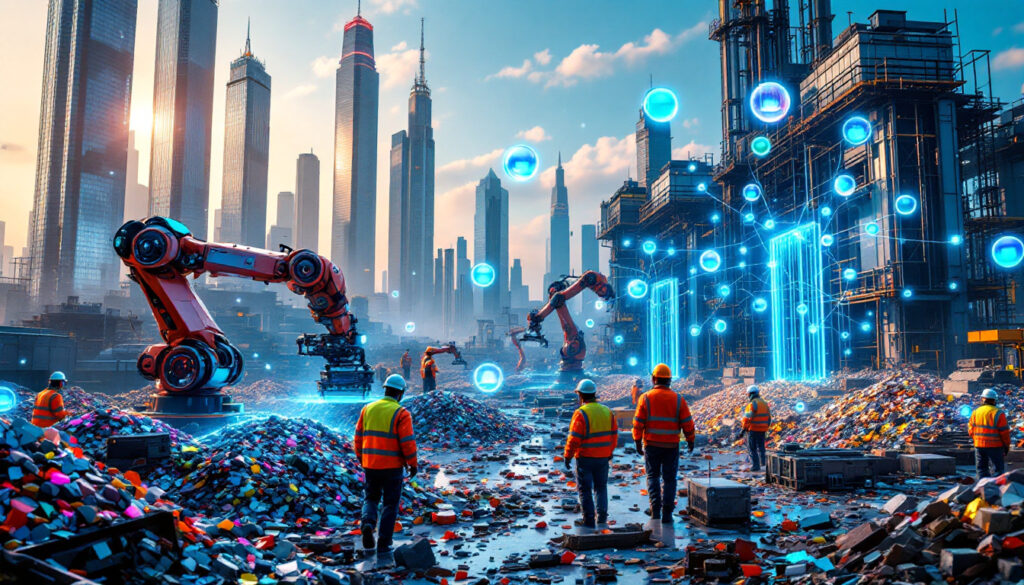What is Urban Mining?
Urban Mining is a concept that views cities, human habitats, and the built environment as potential sources of raw materials. Unlike conventional mining which extracts geological resources, urban mining focuses on recovering materials from the "anthropogenic stock" – the vast accumulation of products, buildings, waste, and mine tailings created by modern society.
By 2025, experts project the global urban mining market will recover over 50 million metric tons of metals annually, reducing dependency on virgin resource extraction by approximately 15%. This represents not just an environmental initiative, but a strategic approach to resource management in an increasingly material-constrained world.
The Anthropogenic Stock Explained
The anthropogenic stock comprises human-generated materials in three main categories:
- In-use materials: Products and infrastructure currently serving their intended purpose
- End-of-life materials: Discarded products awaiting processing
- Historical deposits: Materials in landfills and legacy waste sites
For copper alone, the global anthropogenic stock exceeds 500 million tons—equivalent to approximately 20 years of current mining output. This "above-ground mine" grows daily as more products reach end-of-life status.
Urban mining recognizes that the concentration of valuable metals in electronic waste often exceeds that of natural ore deposits. For example, a ton of smartphones contains 100-300g of gold—a concentration 50 times higher than that found in typical gold mines.
Urban Mining vs. Traditional Recycling
Urban mining significantly expands beyond conventional recycling in several key ways:
- Systemic approach: Treats entire urban environments as resource repositories rather than focusing on specific waste streams
- Material complexity: Addresses composite materials and complex products that traditional recycling struggles to process
- Strategic planning: Incorporates resource recovery into urban planning and infrastructure development
- Technology integration: Employs advanced mining technologies to maximize recovery yields
While traditional recycling typically focuses on basic materials like paper, glass, and some plastics, urban mining targets high-value materials embedded in complex products, including precious metals, rare earth elements, and specialized alloys.
What Benefits Does Urban Mining Provide?
Urban mining delivers multiple environmental, economic, and strategic advantages that complement traditional resource extraction methods.
Strengthening the Circular Economy
Urban mining serves as a cornerstone of circular economy principles by:
- Reducing primary resource extraction by up to 30% for certain metals
- Extending material lifecycles through multiple use phases
- Creating local jobs in collection, processing, and refining operations
- Establishing regional resource security independent of global supply volatilities
The European Commission estimates that robust urban mining could generate over 30,000 new jobs while reducing the EU's raw material import dependency by 20% by 2030.
Improving Resource Security
In a world where geopolitical tensions increasingly affect resource availability, urban mining offers strategic advantages:
- Reduces dependency on politically unstable regions for critical minerals
- Shortens supply chains by localizing material recovery
- Buffers against price fluctuations in international commodity markets
- Provides domestic sources of materials classified as "critical" or "strategic"
The United States currently imports 80% of its rare earth elements despite having substantial "above-ground mines" in the form of discarded electronics. By developing urban mining capacity, countries can significantly reduce these vulnerabilities.
Environmental Benefits
The environmental advantages of urban mining compared to conventional extraction are substantial:
- Energy savings of 85-95% for aluminum recovery versus primary production
- Water consumption reduction of 40-80% across various metals
- Prevention of toxic leachate from electronic waste in landfills
- Reduction in mining-related habitat destruction and biodiversity loss
A study by the Fraunhofer Institute commissioned by the International Copper Association found that secondary copper production generates approximately 1.5 tons of CO2 per ton of metal, compared to 4.5 tons for primary production—a 67% reduction in carbon footprint.
What Materials Can Be Recovered Through Urban Mining?
High-Value Metals in Electronic Waste
Electronic waste represents one of the richest urban mining opportunities. A single metric ton of circuit boards can contain:
- 200-800 grams of gold
- 5-10 kilograms of silver
- 60-300 kilograms of copper
- Significant quantities of palladium, platinum, and rare earth elements
Advanced hydrometallurgical processes now achieve up to 98% recovery efficiency for these metals, making e-waste recycling increasingly competitive with primary extraction. With global e-waste generation exceeding 50 million tons annually and growing at 3-5% per year, this resource stream continues to expand.
Building and Infrastructure Materials
The built environment represents the largest component of anthropogenic stock:
- Steel from structures (92% recoverable through modern techniques)
- Copper from electrical wiring (estimated 35 million tons in US buildings alone)
- Aluminum from windows, doors, and fixtures
- Concrete and aggregates (which can be processed into new construction materials)
When buildings reach the end of their useful life, strategic deconstruction rather than demolition can recover up to 90% of embedded materials for reuse or recycling.
Landfill Mining Opportunities
Historical landfills contain vast quantities of recoverable materials:
- Metals from pre-recycling era disposals
- Combustible fractions that can generate energy
- Soil-like fractions usable in construction or remediation
While technically challenging, landfill mining operations in Europe have demonstrated recovery rates of 20-55% of landfill volume as recyclable or valuable materials.
What Challenges Limit Urban Mining?
Despite its promise, urban mining faces significant limitations that must be addressed through technological innovation, policy support, and market development.
Technical and Infrastructure Limitations
The processing infrastructure for secondary materials remains underdeveloped in many regions:
- The United States lacks secondary copper smelters, necessitating export of copper-rich scrap
- Rare earth element recycling requires specialized facilities currently concentrated in China
- Battery recycling technologies struggle to match the pace of electric vehicle adoption
This infrastructure gap creates bottlenecks in material recovery chains and limits overall system efficiency. China's near-monopoly on neodymium recycling from magnets creates particular vulnerability for industries dependent on these materials.
Economic Viability Concerns
Market conditions significantly impact urban mining feasibility:
- Manual disassembly costs can exceed $200 per ton for complex electronic products
- Virgin material prices often exclude environmental externalities, creating uneven competition
- Volatile commodity markets create uncertainty for capital-intensive recovery operations
- The true value of many recovered materials remains unrecognized in conventional pricing models
For example, while copper market prices hover around $8,000-9,000 per ton, many urban mining operations require prices above $6,500 per ton to maintain profitability, creating vulnerability during market downturns. Furthermore, conducting thorough economic viability studies is essential before establishing large-scale urban mining operations.
Regulatory Disparities
Inconsistent regulations create barriers to efficient material recovery:
- Cross-border differences in waste classification hinder international material flows
- Inadequate extended producer responsibility frameworks in many regions
- Insufficient design-for-disassembly requirements for new products
- Uneven enforcement of landfill bans and recycling mandates
The Basel Convention restrictions on e-waste movement, while intended to prevent dumping, can sometimes impede legitimate material recovery operations by restricting flows to specialized processing facilities.
How Does Urban Mining Vary Globally?
European Union Approach
The EU leads in urban mining policy development through:
- The Circular Economy Action Plan targeting 65% municipal waste recycling by 2035
- Mandatory extended producer responsibility schemes for electronics, batteries, and vehicles
- Strategic investment in recovery technologies through Horizon Europe funding
- Standardized ecodesign requirements facilitating end-of-life dismantling
Despite these advantages, high labor costs and strict environmental regulations create challenges for certain recovery operations. The EU recovers approximately 42% of its e-waste through formal channels, with significant quantities still escaping the system.
United States Landscape
The U.S. urban mining landscape features:
- Market-driven recovery systems with limited federal mandates
- Strong metal recycling infrastructure for vehicles and construction waste
- Significant infrastructure gaps for complex electronic product processing
- Emerging state-level extended producer responsibility legislation
The recycling rate for consumer electronics in the U.S. stands at approximately 15-20%, significantly lower than EU rates. Recent infrastructure legislation allocates $6 billion for secondary material processing facilities, potentially addressing critical gaps.
China's Urban Mining Industry
China has developed the world's largest urban mining infrastructure:
- 29 officially designated "Urban Mining Demonstration Bases"
- World-leading capacity for e-waste processing and metal recovery
- Integration of formal and informal collection networks
- Strategic investment in processing technologies for critical materials
China's combination of abundant labor, industrial policy support, and manufacturing demand creates favorable conditions for urban mining operations. However, recent restrictions on scrap imports under the "National Sword" policy have disrupted global material flows.
How Can Urban Mining Be Scaled Up?
Regulatory Frameworks and Incentives
Effective policies to accelerate urban mining include:
- Landfill bans for recyclable materials (which have boosted recovery rates by 55% in early-adopter regions)
- Harmonized product design standards requiring disassembly documentation
- Tax incentives for secondary material utilization in manufacturing
- Public procurement preferences for products with recycled content
Countries with mandatory extended producer responsibility legislation demonstrate e-waste collection rates 25-40% higher than those relying on voluntary initiatives. Additionally, addressing ESG challenges in mining is essential for the sustainable growth of urban mining practices.
Infrastructure Development Requirements
Critical infrastructure needs include:
- Regional material recovery facilities for complex products
- Specialized metallurgical processing for high-tech materials
- Digital tracking systems for material flows
- Research centers for developing advanced recovery technologies
The capital investment required for adequate global urban mining infrastructure is estimated at $40-60 billion over the next decade, potentially yielding returns of $80-120 billion through recovered materials.
Industry's Role in Enabling Urban Mining
Manufacturers can facilitate urban mining through:
- Design for disassembly and recycling
- Material selection favoring recoverable resources
- Digital product passports documenting material content
- Voluntary take-back programs exceeding regulatory requirements
Companies implementing these practices report average cost reductions of 12-18% in material procurement over five-year periods, demonstrating the business case for circular design approaches.
Advanced Technology Development
Technological innovations accelerating urban mining include:
- AI-powered robotic disassembly systems increasing processing speed by 400%
- Advanced spectroscopy for rapid material identification
- Blockchain tracking of material composition through product lifecycles
- Bioleaching processes using bacteria to extract metals from low-grade sources
These technologies collectively have the potential to reduce processing costs by 30-50% while increasing recovery yields by 15-25%.
What is the Future of Urban Mining?
Growing Importance in the Resource Mix
Urban mining's contribution to global material supply is projected to grow substantially:
- Providing up to 50% of copper demand by 2040
- Meeting 75% of lithium needs through battery recycling
- Supplying 35% of rare earth elements by 2035
As virgin resource grades decline and extraction costs increase, the economic competitiveness of urban mining will continue to improve. The World Economic Forum estimates that by 2050, urban mining could supply more than 40% of global metal needs.
Integration with Conventional Mining
The future resource landscape will feature complementary approaches:
- Primary mining focusing on expanding material stocks
- Urban mining optimizing material flows and circulation
- Hybrid business models where mining companies invest in recovery operations
- Integrated resource planning considering both above and below-ground sources
Leading mining companies are already diversifying into urban mining, with investments exceeding $5 billion in recovery technologies and facilities over the past five years. Many are also exploring mining decarbonisation insights to align with global sustainability goals.
Potential Game-Changing Innovations
Emerging technologies may revolutionize urban mining economics:
- Self-disassembling materials triggered by specific stimuli
- Molecular recognition systems for ultra-precise sorting
- Room-temperature superconductors enabling energy-efficient processing
- Synthetic biology approaches to metal concentration and extraction
These innovations could reduce recovery costs by 60-80% while increasing yields to near-theoretical maximum levels, potentially rendering urban mining economically superior to conventional extraction for most metals.
FAQs About Urban Mining
What materials offer the highest recovery value in urban mining?
Precious metals and rare earth elements generally yield the highest value-to-weight ratios in urban mining operations. A ton of smartphones contains approximately 300 times more gold than a ton of gold ore. Palladium and platinum from catalytic converters, lithium and cobalt from batteries, and neodymium from magnets also represent high-value recovery targets.
How does urban mining compare to conventional mining in environmental impact?
Urban mining typically generates 60-90% lower carbon emissions than conventional mining for equivalent metal production. Water consumption is reduced by 40-80%, and land disturbance is virtually eliminated. Energy requirements for aluminum recovery are 95% lower than primary production, while copper recycling requires 85% less energy than conventional mining and refining.
What role can consumers play in supporting urban mining?
Consumers support urban mining by:
- Participating in formal e-waste collection programs
- Selecting products designed for repair and recycling
- Supporting right-to-repair legislation
- Choosing products with recycled content
Consumer participation in collection systems is particularly critical, as it determines whether end-of-life products enter recovery channels or are lost to landfills.
How can businesses incorporate urban mining into their sustainability strategies?
Companies can leverage urban mining by:
- Redesigning products for modularity and material recovery
- Establishing take-back programs to secure material inputs
- Including recovered material content in procurement specifications
- Investing in clean energy investments and sustainable recovery technologies
Leading electronic manufacturers have established closed-loop systems recovering over 1.2 million tons of materials annually from their products, demonstrating significant cost savings and environmental benefits. According to Ecocycle Australia, businesses that implement comprehensive urban mining strategies can reduce their raw material costs by up to 30% while significantly improving their sustainability metrics.
Ready to Capitalise on the Next Major Mineral Discovery?
Discovery Alert's proprietary Discovery IQ model delivers instant notifications on significant ASX mineral discoveries, transforming complex data into actionable investment insights. Understand why major discoveries can lead to exceptional returns by exploring the dedicated discoveries page and begin your 30-day free trial today.




